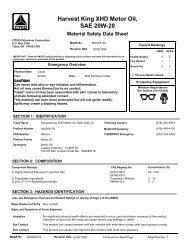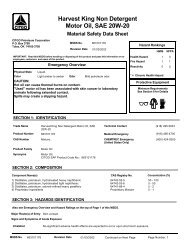5457 Harvest King GL-5 Gear Oil, SAE 80W (English) CITGO MSDS
5457 Harvest King GL-5 Gear Oil, SAE 80W (English) CITGO MSDS
5457 Harvest King GL-5 Gear Oil, SAE 80W (English) CITGO MSDS
You also want an ePaper? Increase the reach of your titles
YUMPU automatically turns print PDFs into web optimized ePapers that Google loves.
Skin Contact<br />
Ingestion<br />
Chronic Health Effects<br />
Summary<br />
Conditions Aggravated<br />
by Exposure<br />
<strong>Harvest</strong> <strong>King</strong> <strong>GL</strong>-5 <strong>Gear</strong> <strong>Oil</strong>, <strong>SAE</strong> <strong>80W</strong><br />
No skin irritation is expected from short-term exposure. Prolonged or repeated contact can result in<br />
defatting and drying of the skin which may result in skin irritation and rash (dermatitis).<br />
Contains a petroleum-based mineral oil. Prolonged or repeated skin contact can cause mild irritation and<br />
inflammation characterized by drying, cracking, (dermatitis) or oil acne. Repeated or prolonged inhalation<br />
of petroleum-based mineral oil mists at concentrations above applicable workplace exposure levels can<br />
cause respiratory irritation or other pulmonary effects.<br />
Target Organs This material may cause damage to the following organs: skin.<br />
Carcinogenic Potential<br />
If swallowed, large volumes of material can cause generalized depression, headache, drowsiness, nausea,<br />
vomiting and diarrhea. Smaller doses can cause a laxative effect. If aspirated into the lungs, liquid can<br />
cause lung damage.<br />
Medical conditions aggravated by exposure to this material may include pre-existing skin disorders.<br />
This product does not contain any components at concentrations above 0.1% which are considered<br />
carcinogenic by OSHA, IARC or NTP.<br />
OSHA Hazard Classification is indicated by an "X" in the box adjacent to the hazard title. If no "X" is present, the product does not exhibit the<br />
hazard as defined in the OSHA Hazard Communication Standard (29 CFR 1910.1200).<br />
Irritant<br />
Sensitizer<br />
Corrosive<br />
OSHA Health Hazard Classification OSHA Physical Hazard Classification<br />
Toxic<br />
Highly Toxic<br />
Carcinogenic<br />
SECTION 4: FIRST AID MEASURES<br />
Inhalation<br />
Eye Contact<br />
Skin Contact<br />
Ingestion<br />
Notes to Physician<br />
Combustible<br />
Flammable<br />
Compressed Gas<br />
Explosive<br />
Oxidizer<br />
Organic Peroxide<br />
Pyrophoric<br />
Water-reactive<br />
Unstable<br />
Take proper precautions to ensure your own health and safety before attempting rescue or providing first aid. For more specific<br />
information, refer to Exposure Controls and Personal Protection in Section 8 of this <strong>MSDS</strong>.<br />
Vaporization is not expected at ambient temperatures. This material is not expected to cause<br />
inhalation-related disorders under anticipated conditions of use. In case of overexposure, move the<br />
person to fresh air.<br />
Check for and remove contact lenses. Flush eyes with cool, clean, low-pressure water while<br />
occasionally lifting and lowering eyelids. Seek medical attention if excessive tearing, redness, or pain<br />
persists.<br />
If burned by hot material, cool skin by quenching with large amounts of cool water. Remove<br />
contaminated shoes and clothing. Wipe off excess material. Wash exposed skin with mild soap and<br />
water. Seek medical attention if tissue appears damaged or if pain or irritation persists. Thoroughly<br />
clean contaminated clothing before reuse. Discard contaminated leather goods. If material is injected<br />
under the skin, seek medical attention immediately.<br />
Do not induce vomiting unless directed to by a physician. Do not give anything to drink unless directed<br />
to by a physician. Never give anything by mouth to a person who is not fully conscious. If significant<br />
amounts are swallowed or irritation or discomfort occurs, seek medical attention immediately.<br />
The viscosity range of the product represented by this <strong>MSDS</strong> is 100 to 400 SUS at 100° F. Accordingly,<br />
upon ingestion there is a low to moderate risk of aspiration. Careful gastric lavage may be considered<br />
to evacuate large quantities of material. Subcutaneous or intramuscular injection requires prompt<br />
surgical debridement.<br />
<strong>MSDS</strong> No. 664645176<br />
Revision Date 08/21/2002<br />
Continued on Next Page Page Number: 2




